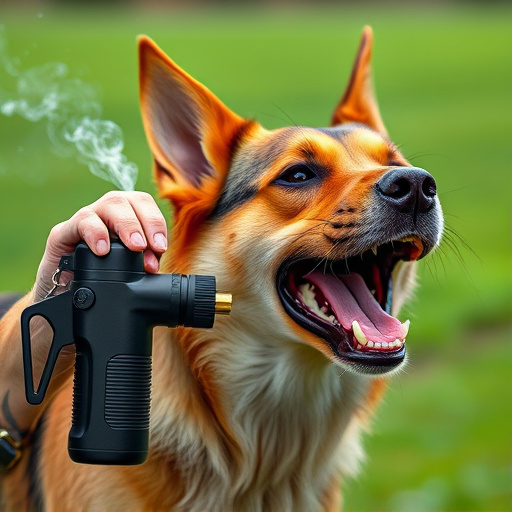Dog deterrent spray (mace spray) is a last-resort safety tool for runners facing potential dog attacks. Effective use involves deploying the spray at an imminent threat, targeting a dog's eyes and nose to temporarily disable it. Popular techniques emphasize learning optimal distance, stimulating a dog's sensory organs with quick effects, and promoting positive behavior through treats or playtime. Ethical training methods, including positive reinforcement, are crucial for deterring attacks while avoiding harm or fear.
Runners often encounter dogs on their trails, which can pose a safety concern. Dog deterrent spray, like pepper spray, offers a non-lethal solution for self-defense. This article delves into the effectiveness of this tactic, exploring its role in runners’ safety and the science behind it. We examine proper mace spray dog training techniques, emphasizing ethical considerations to ensure both runner and canine well-being while navigating potential confrontations.
- Understanding the Role of Dog Deterrent Spray in Runner's Safety
- The Science Behind Effective Dog Training with Pepper Spray
- Implementing Safe and Ethical Mace Spray Dog Training Techniques
Understanding the Role of Dog Deterrent Spray in Runner's Safety
Dog deterrent spray, often referred to as “mace spray,” plays a crucial role in enhancing runner’s safety when facing potential dog attacks. It serves as a last resort protection mechanism for runners who encounter unfriendly dogs during their outdoor activities. By understanding and employing proper mace spray dog training techniques, runners can effectively deter aggressive dogs without causing them harm.
The key lies in using these sprays thoughtfully. Runners should aim to deploy the spray when faced with an imminent threat, targeting the dog’s eyes and nose to temporarily incapacitate it. It’s important to note that proper training involves learning the right distance to use the spray, ensuring minimal impact on bystanders or the environment. With the right techniques, runners can defend themselves and potentially avoid serious injuries caused by dog attacks.
The Science Behind Effective Dog Training with Pepper Spray
The use of pepper spray, or proper Mace spray dog training techniques, as a deterrent for runners facing aggressive dogs has gained attention due to its rapid effects and relatively non-lethal nature. The science behind this method lies in stimulating the dog’s sensory organs, specifically the eyes and nose. Pepper spray contains capsaicin, the compound that gives chili peppers their heat. When sprayed onto a dog’s face, it triggers nerve endings, causing temporary blindness, teary eyes, and difficulty breathing. This sudden disruption in their sensory perception discourages aggressive behavior, allowing runners to escape safely.
Effective training involves more than just spraying; it requires understanding canine behavior and body language. Trainers should teach dogs to associate the presence of pepper spray with a positive response, such as a favorite treat or playtime, rather than punishment. By doing so, the dog’s natural instinct is to react positively when sensing the spray, reducing aggression. Proper Mace spray dog training techniques, when used ethically and responsibly, can be an effective tool in both deterring attacks and promoting positive canine behavior.
Implementing Safe and Ethical Mace Spray Dog Training Techniques
Implementing proper Mace spray dog training techniques is essential to ensure safety and ethics in deterring canine intruders. This method should be approached with careful consideration, focusing on positive reinforcement and humane methods rather than punishment. By teaching dogs an association between certain actions (e.g., approaching the property) and a mild, controlled spray, owners can effectively protect their spaces without causing harm or fear.
Training begins with establishing a safe environment and building a strong bond between the dog and its owner. Positive reinforcement techniques, such as treats and praise, should be used to encourage desired behaviors. The Mace spray is introduced gradually, starting with a mock-up scenario, allowing the dog to understand the spray’s purpose without the actual release. Through consistent practice and patience, dogs can learn to recognize and respond appropriately to the warning sign of the spray, thus deterring potential intruders in a safe and humane manner.
In conclusion, proper Mace spray dog training techniques, when implemented ethically and safely, can significantly enhance runner’s defense against aggressive canines. Understanding the science behind its effectiveness and the role it plays in overall safety is crucial. By adhering to safe practices, runners can navigate their trails with increased confidence, knowing they have a reliable tool to deter potential threats from dogs, thus fostering a more secure and enjoyable outdoor experience.
